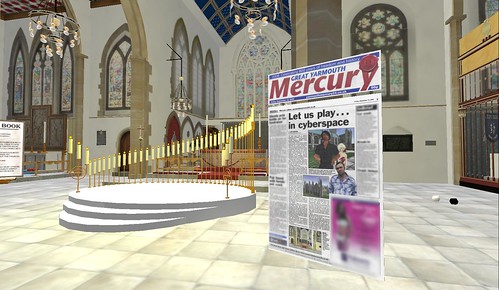Yes this is a blog written by IBMers, but it would be wrong to not comment on things happening in an industry that we helped energize simply because a perceived competitor is doing some unusual things.
Remember, these are my thoughts not IBMs.
The last few days have seen a plethora of virtual world pitches, reports, articles and blog posts around certain types of virtual world platform.
The first was over at @monkchips a.k.a James Governor analyst blog around a visit to microsoft to see about the ESP platform. This appears to be a high fidelity simulation platform and toolkit.
The second was widely reported but Wagner’s new world notes is the one most of the metarati will have read on the matter. This centres around some statments by Craig Mundie that avatar based interaction was of limited interest and really it was photosynth that was the way forward, modelling the real world from photos.
The third is the current blackout on Xbox Live for a system upgrade, widely expected to be the bassis for the new avatar based experience (a mix of Mii and PS3 Home).
The fourth is the OpenSim powered project manhattan, with some very clear Microsoft flavour to it.
So comments I have left around various places on all this are worth tying up.
Whilst there may appear to be conflicting messages, in particular the quote about limited interest in avatar based interactions yet it really may just come from a large corporation not having a central voice. Who is the microsoft metaverse evangelist. Maybe they need to appoint one?
That aside, the interesting thing here is that all the dicussion is not about why would anyone want a virtual world, but instead what sort is best. That seems to be progress?
Also many of the photosynth and ESP elements are geared around mirror worlds. A quadrant of the industry, but by no means the only reason for virtual worlds to exist. They form a great basis too for augmented reality. There is no need to rebuild the world as it is today, but we can enhance it by seeing the data around us. Human communication and in particular the non verbal communication of standing near someone may be far more engaging than a fully realistic model of somewhere that already exists. Though that is a different reason.
The realistic nature of interactions in a model may or may not be important. Yes in a flight sim or fire training it is important accuracy and fidelity counts, but a cartoon style interaction may be all that is needed to get a point across in a meeting. As we really should link more to the games industry, not all games are photo realistic. Not all films are purely based on real world locations. In a user generated environment if the backdrop is too real, you just can build any old thing as it would look out of place.
So it seems there is room for everything and platform arguments are just the usual IT problem that we face, which again sounds good to me, we are in normal territory.
I again point back to my reverse ICE model of interaction different modes of interaction have very different needs across the spectrum. Its not worth dissing any one of them, they are all relevant.
12 Seconds for the future of manufacturing and virtual worlds
I have been introduced to 12seconds.tv, micro video blogging. I just had to record the future of manufacturing in 12 seconds. Fabjectory and Shapeways leading the way. Making virtual things real.
3d printing the future of manufacturing on 12seconds.tv
Next stop London for VWFE08 Oct 6th/7th
The next big conference and expo for all things virtual world is happening in London in 2 weeks time. Its the second year of the Virtual Worlds Forum Europe and a few of your favourite eightbars will be in attendance, aswell as a more formal IBM presence. (IBM is a sponsor).
Rob and I will be around at the event as will Holly and Kevin. Lots of brit metarati.

It is particularly interesting for us as many of you know Rob and I and Roo before work for the global CIO office. Our director of technology and innovation Luba Cherbakov is flying over to present at this event. As you know we do a lot of work with enterpise virtual worlds and how we can use that inside our company and also help others understand this growing market.
This year there is a mixture of expo and congress. So if you need to come have a chat Rob and I will more than likely be around the IBM stand.
Of particular interest is to me is the lead sponsor Unity3d as you would have seen from some of the previous posts this has been an area of exploration that Rob has been diving inot recently (along with OpenSim), in particular with the pub/sub messaging extending what is already done here at Hursley.
Last years event was very enjoyable. The mix of actual game based firms and enterprise firms with a certain creative twist is very London and very Europe.
So come and see us at the expo or at the after show parties.
We are on TV… again. This time Sky
The recent hursley 50th has yielded this great bit of footage.
The whole package is great, but 4 mins in, yours truly rocking the virtual world
Yes I do quote(with attribution) the famous Warcraft is the new golf phrase. 🙂
I also seem to have become the lead story on the event. Fancy that.
Hursley 50th celebrations with added metaverse
This week has seen the official part of the IBM Hursley 50th anniversary celebrations. To mark the occasion we have had 3 days of visitors to little country estate in Hampshire, with a mix of presentations and expo’s of all the things that are done here.
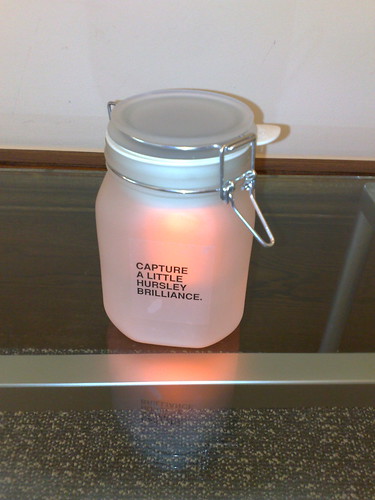
We had a visit from John Denham, Secretary of State for innovation, university and skills which involved a tour around the entire site expo.
We then had a day of customer visitors, featuring some presentations, expo walk arounds and presentations in the new Innovation Centre here in Hursley (which needs a post of its own!)
The next day saw members of the press, including TV crews come and do some interviews and see the show.
That ended the visits but we then ran the expo for the 3,000 employees on site to come and talk.
The really cool thing for us here at eightbar was our position in both the expo and on the schedule of speakers. Rob had the stand up and running with lots of people drawn to and interested in the nice innovation award, unity3d, metaverse, opensim etc. I helped out there when I could, but I had lots of 1:1 interviews and conversations to do as well as presenting my usual Virtual Worlds pitch.
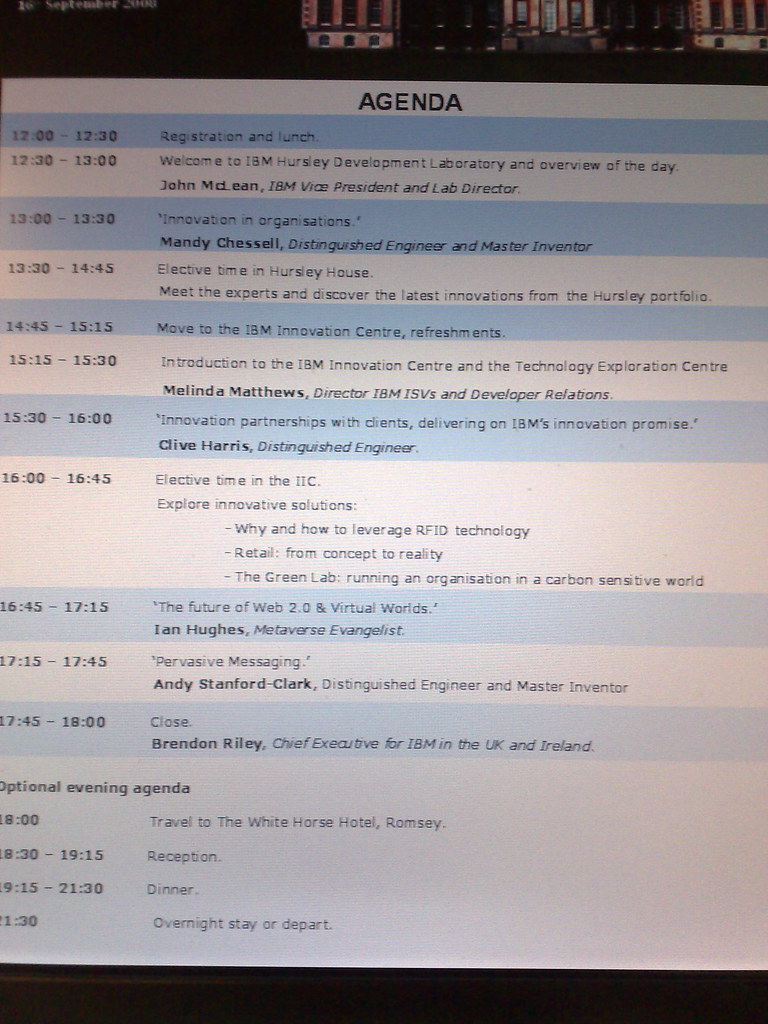
So there I was nestled admist the Lab Director, Chief Executive and Distinguished Engineers spreading the word about eightbar and metaverses.
It was also important as it belnds with what Hursley already does. Hursley is the home of messaging and of transaction processing. As you saw from the recent post we are very much implementing MQ pub/sub messaging across our CIO projects in various virtual worlds to achieve a different level of interoperability. Gordy and I also have a patent filed on transaction processing. Bear in mind CICS (which runs many of the transactions many of you make daily in banking) is 30 40 years old. So CICS still has relevance in dealing with complex transactions in a virtual world too.
The food was pretty good to at the events.
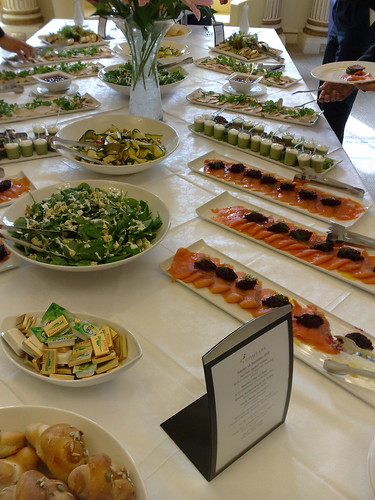
I include this photo becuase a fellow IBMer said “I suppose that will end up on the internet?” erm… yes 🙂
Also we dont just turn up at these things, lots of extra effort goes into it. Rob’s posters are a prime example, representing all of Emerging Tech here in Hursley.
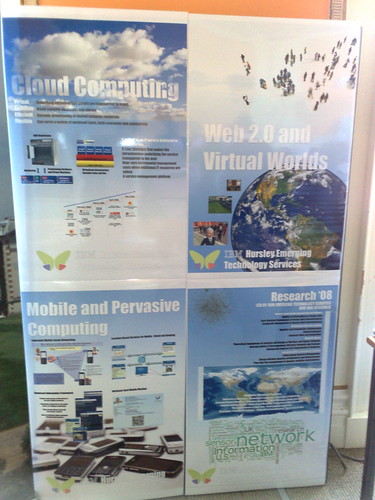
The mobile and pervasive piece bottom left was not clipart, but planned by rob in a photo shoot having collected lots of mobiles from us and from Dave’s office. Planned, photographed, built into a poster, sent for printing and mounting, put up and then explained for 4 days by Rob, Bharat(pervasive) and Jules(cloud).
So I wonder what the new kid on the block that mucles its way onto the agenda will be in 50 years time?
Web 2.0 to OpenSim made easy (JSON support added)
I’ve been tracking the progress of the OpenSim project for quite some time now and gradually delving deeper into the midst of this little open-source wonder.
For those of you who haven’t come across OpenSim, or have heard of it but haven’t investigated in too much detail; OpenSim is a Virtual Worlds platform built from the ground up which uses the Second Life protocol. Initially OpenSim has set out to emulate the current function of the Second Life servers. This means that you use the Second Life client to log onto an OpenSim server.
OpenSim has been built in a modular fashion, meaning that particular modules can be swapped in and out depending on the purpose of the Virtual World you wish to run. At the moment the modules are limited to things like… support for different databases, physics engines, scripting engines etc.
In the future I expect to see a whole raft of new modules ranging from the important but slightly mundane, authentication e.g. LDAP, OpenID etc. to plugins allowing different client types e.g. Flash, Unity etc. and modules for payment systems etc.
At the moment OpenSim is still in alpha, with stability a high priority. Already though it is becoming well fleshed out with building, avatar customization the ability to connect multiple sims (islands) together and a healthy base of scripting available enabling the majority of existing LSL scripts to run and also allowing c# and other languages to be used.
In addition to the LSL scripting ported from Second Life there are extra API calls that can be made that enable function such as loading images from the web directly onto objects in world. There is also a scripting API that lets you format text and images on objects.
As I have become more involved in OpenSim and got to learn how it works a bit more I thought it time to start contributing something towards the codebase. A long time ago in Second Life I created a translation device that listened to your conversation and sent the text out to Google to be translated, it then read out the translation in world.
There are many other services in Second Life that use this pattern of utilizing services around the Web. The LSL scripting language however is not good at handling the formats that most Web 2.0 APIs and services speak. In fact may SL gadgets and devices rely on custom web server scripts to speak to the outside service and cut down the data drastically before its passed back into SL where the gadget uses it. This is a major pain in the ass as any SL gadget creator will tell you.
One of the most common formats used by Web 2.0 service APIs (Google,Flickr, Yahoo etc.) is called JSON (or javascript object notation). JSON is a simple way of describing objects, however it can come in many shapes and sizes making it almost possible to consume directly in SL or OpenSim.
For that reason my first contribution to the OpenSim project is to implement a scripting function called osParseJSON, which should hopefully open the flood gates for people who want to make the most of the Web 2.0 services they use every day and get that data into OpenSim.
For now I’ve written a simple example, that uses Googles translation API. The example lets you translate between 23 different languages.
Hometown serendipity St Nicholas Church in Second Life
Today I received a call from my dad, he had seen a news article in my hometown newspaper the fabled Gt Yarmouth Mercury. Great Yarmouth (for those not of a UK disposition) is far on the east coast of england, the round bit that stick out and is just north of the most easterly point in the isles. Now Dad has just taken to the interwebs with a new computer and has started to get to grips with all this stuff. The news article in the local paper was about a build in Second Life of the iconic and historically significant building in St Nicholas’s Church.
I decided to pop along and have a look, and I have to say that I really liked what I saw. Obviously mirror world builds are a significant part of any virtual world experience. To see it break in the press back home stating “Second Life became very well known at the end of 2006 when major companies took an interest” (ahem…. I wonder who that was then 🙂 go eightbar)
Anyway, I popped along, took these photos and was lucky enough to bump into the creator Sid Corleone and have a chat on the roof of the church (nearly a cathedral in size). It was interesting as Sid was building this to generate funds for the real building, but not from a strong religious conviction, but a historical and architectural one. Sid also told me of some future plans around the area, something I was more than happy to help with. Great Yarmouth has, for instance, the original Nelson’s Column. I suggested that he reminds the locals he is trying to help that a “minor celebrity” metaverse evangelist was born and bred in the area.
To add to the serendipity of the moment, Sid’s surname is that of the godfather. In ActiveWorlds i tended to use the godfather AV and in v-side I have a very nice godfather shirt I wear. Tenuous, but relevant and memorable connections I feel.
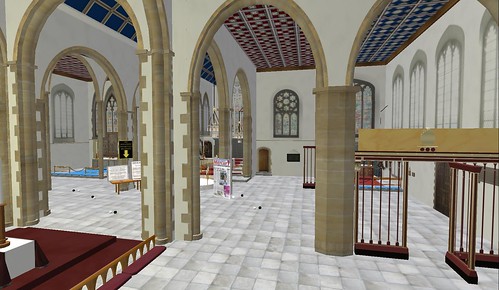
Here is one of the interior shots, Sid is still working, but has opened to show it off.
Sid also has put a copy of the news article that led me there in the first place in the church
Yes that is an evangelist in the pulpit

Sid has used lots of real world photos to texture the environment. Here is the arch over the door featuring the heraldic crest of Great Yarmouth
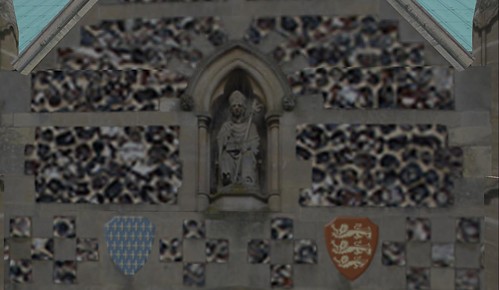
So where is it? I hear you ask. It’s here on Rosslyn go and take a look and welcome Sid to the metarati fold.
BTW if anyone wants to add epredator in as a notable resident on wikipedia please do 😉
Moving cubes from world to world
Today led to a rather exciting development. Since the original experiments with Second Life many of us from Hursley have wanted to apply the elements of pub/sub messaging that Hursley is known for to the transport of events from various virtual worlds.
Rob augmented his very cool Unity3d server worlds with the ability to consumer published messages on one of our many message brokers. This means any client that is subscribed to a particular message on the hub can take action. Having this in place meant we were able to do what was in this video.
Creating a cube in Second Life, publishes a message to the wider message queue. Several Unity3d clients subscribe to that in various ways and also create a cube.
This is interworld operability at a very different level to the import/export approach. Event brokers of this nature are the way we deliver point by point score data at sub second response times to web scoreboards for things like Wimbledon.
Publishing and subscribing to various messages and topics opens up a whole host of interworld communications that can occur. It still needs a client to understand how to recieve the messages but the beauty of pub/sub is that it can be push related or pull.
I thought I would put this video up and show what we were up to as I told a number of people about the plans we had at VW08 in LA.
So interoperability in virtual worlds from Hursley the home of messaging middleware.
T.I.G Virtual worlds industry outlook 2008-2009
In all the various birthdays, travelling and conferencings I realized I had not written anything here on eightbar to point those of you who dont know about it yet to Christian and Sean’s virtual worlds outlook report. It is certainly a must read document (thats not just because I get a mention either!)
You can get it from the T.I.G blog here
I will write a proper follow up on all the good points and research in that later, I just wanted to redress the horrid gap in my diligence in linking to it.
VW2008 impressions post show
This years west coast event has, as usual, been very full of lots of conversation with all sorts of people. The IBM stand seemed to be a constantly busy place, and my shifts on there certainly were productive in terms of explaining what we do in general and what I do with the CIO office. having the award on the stand for innovation also brought a fair few people over.
I attended some of the sessions, but by no means as many as I would have liked. However it is always a draw between attending things to support the element you represent and know a lot about, to gauge other people positions on things versus hitting the more apparently unrelated topics.
The John Landau session keynote, with Corey from Multiverse intreviewing him was a very interesting start. It highlighted the fact we were in Hollywood. My main take away from this was that some very influential hollywood players were starting to tap into the whole virtual world direction. I was also struck by how much multiverse were now doing or had in the pipeline. Multiverse has always been there, Corey is always a leading voice but they have obvioulsy been in it for the long haul, so that now, several years on they announced the Buffy MMO would be multiverse based.
The next day keynote was started off with Rueben, formerly the Linden Lab Second Life evangelist. He admitted to being the worlds greatest virtual world keynote warmup act as he often has this slot. He talk about how we had to evangelize. A kindred spirit I fully got what he was saying and making all these people who do this now evangelists in their own right with the power to shape the industry is key.
Colin Parris (our IBM VP for all this) also had an interesting keynote with Erica Driver interviewing. This was struck a very good balance with the hollywood one the day before bringing more traditional business but mixed with innovation into the mix. Colin said many of the things I spend my time talking to people about, how the community formed, how it had a grassroots global take up in IBM. How we were investigating and pushing forward things in the enterprise and adding value. Showing the lotus sametime to opensim interoperability. I actually twittered that my work here is done. As Reuben had pointed out before in making everyone now their own evangelist, there is less need for those founding evangelists.
This leads nicely onto the technology visionary panel that I took part in.
This session will analyze the future course of virtual worlds technologies. Join us for debate between leading industry technology experts on the future of the technology, where it’s headed and what needs to be done to get there. Don’t miss this lively conversation.
– John Swords, Director of
Business Development, The Electric Sheep Company (moderator)
– Ian Hughes/epredator Metaverse
Evangelist, IBM
– Ben Goertzel, CEO, Novamente
LLC
– Mark Wallace, Chief Executive,
Wello Horld, Inc.
– Christian Renaud, CEO,
Technology Intelligence Group
We jammed on some subjects about where to take this next. We covered all sorts of ideas. A main theme was that we know this is not all solved technically and socially and we should not just settle for assuming the continuation of this has to be the same modes we have become used to. It may be the case that we need to evolve past avatars and islands. Though they have their place, and we know they work there is more that can be expressed and other metaphors that we can use as we connect humans at a deeper level over the web.
Interoperability, different ways to look at that and the needs of that obviously came up. I extended that interoperability conversation into my pet subject of 3d printers and making the virtual real completing the loop that we have of modelling things from the real to the virtual. We know the technology will get better ( a common theme across many sessions) we have to keep pushing it past what it can do. The reason we have to do that is that it is not actually about the tech. It is about people. All the things we do and try connect people in interesting and rewarding ways.
That segues into the other panel I managed to attend at least half of.
An exploration of cross-platform narrative possibilities, bringing video content into virtual worlds and vice versa.
Tim Kring, Executive Producer/Creator, Heroes
Reuben Steiger, CEO and Founder, Millions of Us (moderator)
Elan Lee, formerly of 42
Entertainment and now founder of Fourth Wall Studios
– Douglas Gayeton, CCO, Millions of Us
– Chris Jacquemin,
Endeavor Talent Agency
I found this fascinating to hear the sort of problems with adoption of new channels that pervades an industry that has such an obvious creative output stream that can benefit from the ways the web now works. It had the same pattern of stagnation and inertia that we see in every other industry. Of course the formulaic nature of the media industry is obvious, as with the games industry, so it is not that big a surprise.
I liked what Tim Kring had to say about Heroes, and how every non TV element of the franchise has to either reach out or feed back to the “mothership”. Yet each individual element has to stand on its own, and be a mini Heroes experience. This was contrasted by the panel with the way many properties were merely repackaged and pasted into other mediums. The consumers now really dont want that.
In the scope of innovation it was suggested that the industry needs another star wars moment to break the mould.
It sounds to me like a few movie studios, tv companies, agencies and hollywood types could do with their own metaverse evangelists too.
Finally I need to talk about Roo’s panel. He was running an augmented reality one. This and 3d printers are very much in my sights now. I guess I can be an ARvangelist?
Augmented Reality: Virtual Interfaces to Tangible Spaces
Augmented reality is an emerging platform with new application areas for museums, edutainment, home entertainment, research, and industry. Novel approaches have taken augmented reality beyond traditional eye-worn or hand-held displays, creating links between the real and virtual worlds. Join this panel of experts as they guide you to where the augmented world is headed next.
– Marc Goodman, Director,
Alcatel-Lucent
– Eric Rice, Producer,
Slackstreet Studios
– Blair MacIntyre,
Associate Professor, School of Interactive Computing, Director, GVU
Center Augmented Environments Lab, Georgia Institute of Technology
– David Orban, Founder & Chief
Evangelist, WideTag, Inc.
– Andrew (Roo) Reynolds,
Portfolio Executive for Social Media, BBC Vision (moderator)
Roo did his usual good job of blending moderation and presentation with comment. The panel was a really good set of people to discuss this. Eric having a huge interest and push in representing stories, games and content, David with intrumentina the world with OpenSpime. Marc with the Alcatel-Lucent technolgies already used in many places including the media and sports coverage and Blair with a huge track record in AR, including some of the more recent and famous experiments using the Second Life client to blend life with the real world.
Other things of note at the conference and expo:
The growth in the capabilities of Mycosm. A show pick and favourite from the New York show, more on that later in its own post, but its looking really good and has some very nice features including being an nuderlying web service based architecture
The Rivers Run Red part of the Second Life stand with the Immersive Workspaces which I think is fair to say our very own Rob Smart had in forming the direction of during a shared IBM/RRR customer project.
Proton Media were doing very well too, a platform that has pretty much everything an enterprise would need for desktop collaboration. Which now includes a free demo ( something we discussed way back at the very first VW conference.
A very cool 3d camera sensor from Soft Kinetic was getting a lot of attention too.
Finally, as I already mentioned before Multiverse had some interesting directions with multiverse places which will be next on my list to explore.
On our own stand many people responded to seeing Rob’s Unity based world running and talking the environment. It would appear unity has captured some peoples imaginations as a platform to develop quickly too.
Thus ends a long post, with no pictures.
Final thought… I do think this industry is on the right track, I do think we have to come to terms with the different needs of different businesses and experiences. The diversity of platform is good in that it allows us to create anything, not be tied into one way. I still have the feeling there is a game changing piece sitting there ready to explode. Either way the end result of being able to merge the real and the virtual, to print, visualize, feel, and extend what happens is offering us a set of new planes to work with. That is very exciting.

